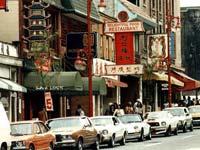Chinatown gets historical site status

Chinatown has been added to Canada’s family of national historic sites on the recommendation of the Historic Sites and Monuments Board of Canada.
Vancouver’s Chinatown is one of the oldest and largest Chinatowns in the country and it has remained a vibrant centre of an evolving and enduring culture expressed through a ‘distinctive urban and cultural landscape’.
The area’s architecture is characterized by a distinctive “recessed balcony” style, a hybrid that blends aspects of Chinese regional architecture with western styles and building methods. It is also one of the earliest established communities of Vancouver and has remained a vital element of the physical and cultural history of the city.
Chinatown is centred on Pender Street and is defined by its form, embellishments, layout and architecture.
The vast majority of Chinatown buildings are constructed at the front property lines on 25-foot lots and occasionally on consolidated lots of 50 feet or more. Most vary in height from two to four storeys. At street level, pedestrians are treated to a lively assortment of commercial uses, with merchandise often spilling onto the sidewalk.
Within Vancouver’s Chinatown there are 70 contiguous properties, representing a mix of primarily commercial but also residential and cultural buildings, courtyards and alleys. Twenty-four of these buildings are listed on the Vancouver Heritage Register. There are 11 Society buildings dating to the early 20th century (1901-1926), as well as significant, newer cultural features such as the Dr. Sun Yat-Sen Chinese Classical Garden and Park (1986), the Chinese Cultural Centre (1981-86) and the Millennium Gate (2002).






